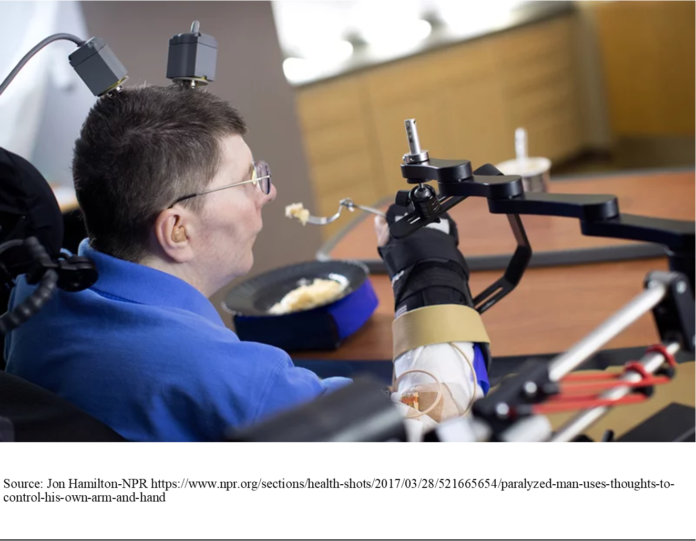By Grant Wang
Imagine playing video games by only using your mind. No controller. No keyboard and mouse. Or moving an object somewhere by just thinking about it. Such a superpower sounds familiar in science fiction or in your wildest dreams. But now, scientists and engineers are turning this superpower into a reality. The technology known as a brain-computer interface is enabling computers to read our minds and carry out the tasks in our thoughts.
In 2009, a bicycle accident left Bill Kochevar permanently paralyzed on any part of his body below his shoulders. He couldn’t play catch with his son, type on his computer, or even walk up the stairs. But he never imagined that eight years later, he would regain control over his right arm and hand and even be able to feed himself pretzels again. “I thought about moving my arm and I could move it,” says Kochevar. “I got to be the first guy in the world to do it.” This revolutionary breakthrough is enabled by a brain-computer interface, which reads his thought about moving his arm and then sends this command to the electrodes in his arm.
So how exactly does the machine read our minds? Our brain has nearly 100 billion neurons that are connected in networks. That’s more than the number of people living on 13 Earths! When we are thinking, these neurons interact with each other through synapses, and the way they interact differs when we plan the next family vacation and when we crave a footlong sub. Such interactions generate command-specific signals in the form of electrical impulses. With decades of study to understand how the brain encodes information, scientists have designed brain-computer interfaces to read these signals using sensors and interpret them by recognizing the patterns with sophisticated computer algorithms.
Sensing the precise signals fired by billions of neurons is no easier than finding a needle in a haystack. To receive strong and clean signal waves, the early brain-computer interface must be surgically implanted right on the brain’s surface under the skull. BrainGate is such a brain implant system that has shown astonishing success on patients, ranging from helping the paralyzed walk again to allowing people suffering from locked-in syndrome to communicate with the outside world.
On the other hand, researchers also take on the grand challenge of mind-reading without drilling into the skulls. An electroencephalography (EEG) headset is a helmet with multiple electrodes pressed against the scalp to read brain signals. Because our skull and scalp can be powerful mufflers, the brain signals read by EEG are as weak as a whisper yet as noisy as a conversation at a cocktail party. With the help of emerging artificial intelligence techniques, scientists can now decipher these crude signals to provide more precise information, and in 2019, researchers successfully demonstrated a non-invasive, mind-controlled robotic arm.
“Forget about the Covid crisis,” Dr. Rafael Yuste, a neurobiologist at Columbia University, said. “What’s coming with this new tech can change humanity.” The possibilities have just begun.

